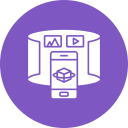Future Trends in Virtual Reality Applications for Schools
The use of virtual reality (VR) in education is rapidly transforming the way teachers engage students and how learners interact with complex concepts. As technology advances, VR is moving from an innovative tool to a fundamental part of the modern classroom. Schools around the world are embracing immersive experiences that foster curiosity, collaboration, and creativity. This page explores the most promising future trends in virtual reality applications for schools, offering insights into how these developments may reshape the educational landscape over the coming years.

Immersive Learning Environments
Traditional field trips often involve substantial costs and logistical complications, limiting the frequency and diversity of student experiences. Virtual reality overcomes those limitations by transporting classes to historical sites, museums, biomes, or even distant planets within seconds. As VR hardware becomes more accessible, schools will increasingly rely on virtual field trips for interactive exploration. This first-hand exposure to real-world contexts deepens comprehension, spark curiosity, and enables students to visit locations or access scenarios that would otherwise be impossible due to distance or safety concerns. With innovation in 3D modeling and interactive storytelling, each virtual field trip becomes more than just visual—it’s a fully immersive, guided discovery experience.

Personalized and Adaptive Learning
One of the most exciting prospects in VR education is the ability to craft individualized learning journeys. Powered by data analytics and sophisticated learning algorithms, future VR platforms will adapt content difficulty, subject pacing, and instructional strategies in real time to meet each learner’s strengths and challenges. Visual, auditory, or kinesthetic preferences can be accommodated with a degree of customization impossible in traditional classrooms. The system’s responsiveness means students are neither bored by repetitive reviews nor lost in advanced material, optimizing engagement and knowledge retention.
Previous
Next
Collaborative and Social Learning in Virtual Worlds
Future VR developments will make it increasingly commonplace for students from multiple schools, cities, or even countries to meet and learn together in shared digital environments. These global classroom connections break down geographical and cultural barriers, fostering empathy, cross-cultural communication, and teamwork. Within these virtual spaces, learners can collaborate on projects, discuss global issues, or participate in cultural exchanges under the guidance of their teachers. As language translation and synchronous communication tools advance, these experiences will become more seamless, enriching the social fabric of education in globally connected communities.
